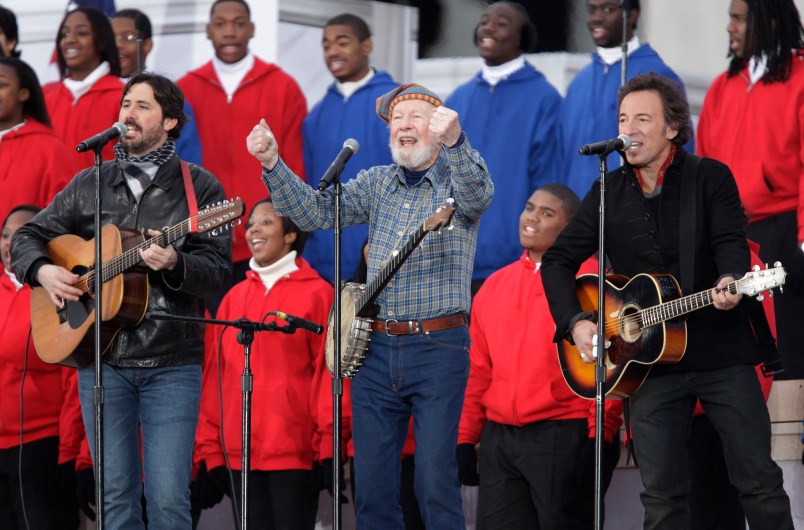When I wrote about Pete Seeger earlier this week I ended on the rendition of This Land is You Land he performed with Bruce Springsteen and his grandson Tao at President Obama’s first inaugural in 2009. As I wrote, “There are many currents of what America is. For a certain one, perhaps for many, that was a transcendent moment of connection.”
Now the Times has collected together a number of musicians’ remembrances of Seeger and one of the best is from Springsteen where he recalls just this event. He also notes the role of John Hammond, a name you may never have heard but a producer, musician, activist, talent scout among many other things who is undoubtedly one of the most significant figures in 20th century American music.
Springsteen mentions Hammond’s role rescuing Seeger by signing him to Columbia records while he was blacklisted in the mid-1950s.
What else did Hammond do? It’s no exaggeration to say that he either discovered or played some key role in the careers of most of the most important American musicians of the 20th century. Some examples. Hammond discovered and/or signed Bob Dylan, Bruce Springsteen, Aretha Franklin, Stevie Ray Vaughan, Billie Holiday, Count Basie among many, many others.
He played a key role in organizing Benny Goodman’s band. He was also the one who essentially introduced Robert Johnson to the public with what was essentially the first issue of any of Johnson’s few recordings in 1961.

John Hammond
In 1938, he organized two concerts at Carnegie Hall called From Spirituals to Swing, which included Count Basie, Benny Goodman, Big Joe Turner, Sonny Terry, Helen Humes, James P. Johnson and others. He had actually arranged for Robert Johnson to be a part of it too but that didn’t happen because Johnson was apparently murdered by a jealous husband in a honky tonk in Greenwood, Mississippi in August 1938.
Johnson was 27.

Robert Johnson, in one of only two known photographs.
On top of all of this Hammond was an accomplished musician and civil rights activist. As I said about Seeger, he’s one of these guys who if you pull his thread from the fabric of 20th century American music, it’s simply not the same.
Here’s Bruce’s recollection (from the Times) of Seeger and that 2009 performance, in which Hammond plays a key role.
“When Pete was on the blacklist in the early ‘60s, his old friend, the legendary music man John Hammond, came to the rescue and signed him to a Columbia Records contract. In the early ‘70s, the same John Hammond signed an unknown kid from New Jersey to a Columbia record contract. When John died in 1987, both Pete and I were asked to play at his funeral and that was the first time I laid eyes on Pete.
“I had missed most of the Hootenanny folk revival and really didn’t have that clear an idea of what Pete actually did. Well, Pete gets up at the memorial, his beautiful voice long since shot, and strums his powerful fingers over his 12-string guitar, ringing out a simple chord, which all by itself sounded simply stirring. He then described the origins of ‘We Shall Overcome,’ and proceeded to talk the audience through the song until every person at that gathering was singing loud and strong.
“Loud, strong, committed and always in search of America – all of it – with a heart of gold and a spine of steel – that was Pete. We got to know each other in the years that followed, and I wound up being so deeply affected by his music that I released an album called ‘The Seeger Sessions,’ inspired entirely by Pete’s artistry.
“One of my favorite memories is of flying down to D.C. with Pete to perform together at President Obama’s inauguration concert. With the great statue of Abe Lincoln behind him and a broad and massive cross section of America at its most hopeful in front of him, he led us all in singing ‘This Land is Your Land.’ As Pete liked to say, he would only sing it with ‘all the verses,’ the last several of which are the most radical and are usually left out. And, as I’ve said before, that, too, was Pete. He always sang ‘all of the verses.’






